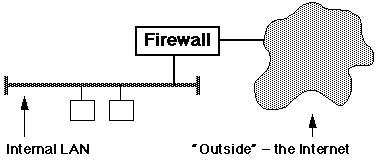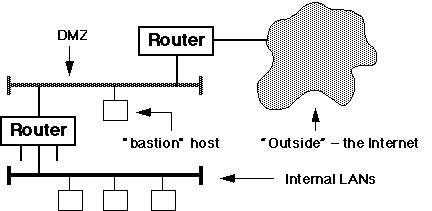Lecture 19: Network Security
The Nature Of Attacks
Computer systems (hosts) connected to the Internet
are subject to an almost constant barrage of security attacks. Most attacks have
at least some of the following goals:
- To obtain unauthorised access to private, or secret, information stored on
the compromised system -- recently the target has often been credit card
numbers stored on commerce servers. Such access can be obtained by a wide
variety of means. This is probably the most important type of attack.
- To use the compromised system as a start point for attacks on other, more
interesting, systems whilst "covering their tracks" -- the (so-called)
Springboard Attack.
- Denial of service (DOS) attacks attempt to use up system
resources to inconvenience legitimate users. A classic example is to send vast
megabytes of (anonymous) electronic mail to a target host in an attempt to
exhaust its disk space. The (relatively) recently developed
Distributed Denial of Service (DDOS) attacks are a
particularly nasty form.
- A variation of the "unauthorised access" attack is where a Bad Guy
actually attempts to cause damage to the compromised system, for example, by
removing important files, changing configurations, etc. Recent "Web site
defacements" come under this category.
- etc, etc...
Internet Security
Most interest in security issues is in connecting to
the Internet in a secure way. Recall:
- An Internet-connected system uses the TCP/IP protocol suite. The TCP/IP
model of communications is based on server processes waiting (at well-known
ports) for remote sites to establish connections.
- A server process has very little information -- usually only an IP address
and a reverse DNS lookup -- about the identity of a remote host which is
attempting to connect. Even reverse lookups can be compromised by manipulation
of DNS tables or by IP Spoofing, where a remote host
generates IP packets that look as though they came from some other system.
- Servers which generally accept all connections without any (initial)
security checks (such as
finger and sendmail) can be
vulnerable to various forms of attack, such as attempted buffer
over-running.[1]
- A major problem is the whether the sysadmin can trust the
server programs to be bug free...An issue here is whether the vendor provides
access to source code for scrutiny.
[1] A successful buffer overrun
attack requires extremely detailed knowledge of the vulnerable target system.
However, many such exploits have been observed over the years. The famous
"Morris Internet Worm" of 1988 was based (among other things) on a buffer
overrun attack on sendmail, the Unix standard package for email delivery.
Firewall Security
A Firewall is a dedicated network box
(usually implemented in the organisation's "gateway" router) situated between
the Internet and an organisation's private network, thus:

There are three classes
of Firewall:
- Packet filtering firewalls
- Application gateways
- Circuit level gateways
Of these, the packet filtering type is the most common.
Because the firewall is not a general-purpose host, it does not itself run
any vulnerable server processes.
Packet Filtering Firewalls
These only permit selected
traffic to pass between the "inside" and "outside" networks.
The decision to forward a packet or to discard it is made by looking into its
protocol headers, usually at either the IP source or destination address. The
TCP or UDP port numbers in the packet can also be used.
TCP (and UDP) level filtering is more complex. and requires the firewall
router to keep much more "state" information. For example, a particular site may
allow outgoing TCP connections for some services (ie, port
numbers), but prohibit most incoming TCP connections. This can
be achieved by examining the ACK bit in the TCP header: it is cleared in the
first connection request segment, and is set in all subsequent segments.
For example, the La Trobe University "gateway" router is configured to block
outgoing port 80 (HTTP) connections, thus forcing Web users within the
University to use the caching proxy
server. At Nilai College, where this
unit is also offered, outgoing HTTP (port 80) connections are permitted and most
other services are blocked at the gateway router.
Packet Filtering Configuration
As an example of how access based on
packet filtering can be configured, consider the approach taken in Cisco(tm)
routers.
An access list is used to define permisible packet flows through the router.
The general form of an access list entry is:
{ permit | deny } address [mask]
The entries have meaning thus:
permit | deny
- indicates whether this entry allows or blocks traffic from the specified
address.
address
- gives the source IP address.
mask
- this (optional) field is interpreted as a "bitmap" which defines the
significance of each bit in the preceding address field. Every bit in the mask
which has a "1" value indicates a "don't care" bit in the address, whereas
every "0" bit indicates a bit in the address which must match exactly.
The access list for each interface can have many entries of the above form.
In addition, an access list can be specified to restrict either incoming or
outgoing packets on the particular interface. Cisco's Extended
ACLs are used for transport-layer (and other complex) filters.
More Complex Firewall Configurations
A more common structure nowadays
uses a de-militarised zone (DMZ) between the internal LAN and
the Internet, thus:

Both of the routers in
this diagram are configured as packet filtering firewalls.
The DMZ is also called a "stub network". Note that the DMZ is, of necessity,
a separate subnet.
There are many options for the level of filtering in the routers, and for the
functionality of the bastion host. These are examined in the next slides.
Application Gateways
In this configuration, the only system which has
access to the outside Internet is the bastion host. In turn, the systems on the
internal LAN (nowadays often referred to as the "Intranet") can only contact the
bastion host, or gateway. Both of these conditions are configured using IP
address-based packet filtering in the routers.
If users connected to the internal LANs wish to use the services of the
outside Internet, they can (eg) telnet to the gateway, and then use standard
tools running on it to access the rest of the Internet.
An example of such a structure is provided by an electronic mail gateway.
Typically, a mail gateway in the DMZ receives messages addressed to an alias
address, such as:
Phil.Scott@latrobe.edu.au
and delivers the message to an appropriate system and person
within the organisation. The MX type in the DNS is used to support such mail
gateway systems.
Circuit Level Gateways
These operate at the level of the
TCP connection (or circuit). In effect, the application gateway
transfers a copy of application-level data between the internal network and the
outside Internet instead of the IP packets themselves.
Such a structure might be used where an internal host wishes to, for example,
fetch a WWW page from a server in the external Internet. The client web browser
establishes a connection to a server which is running on the gateway host. The
gateway server in turn establishes a second connection to the
actual WWW server on the external Internet, and passes the incoming HTML
document back to the internal browser process. Such a server (running on the
gateway, or bastion, host) is called a proxy.
One of the advantages of a proxy server is the caching of
external web pages, thereby potentially reducing traffic on the connection to
the outside Internet.
Real World Firewall Systems
Most installations combine both circuit
level and application gateways, using the DMZ model of the previous slides. As
mentioned, this implies the use of routers which can be configured to do packet
filtering on IP addresses and/or TCP connections.
The bastion host normally runs, for example, the organisation's WWW server,
its FTP server (if applicable) and any other public information services. It
also usually acts as an email gateway. The WWW server usually is configured as a
proxy for the hosts connected to the internal LANs (the
Intranet). It may also perform a similar function for other services such as
FTP.
This type of structure can be very effective, combining many of the best
characteristics of all of the other types. However, the gateway system must
usually be a general-purpose timeshared (and therefore Unix) system, which
raises doubts about the safety and reliability of the proxy software processes.
This is not a solved problem, for obvious reasons.
Although... Highly secure versions of Unix for just such applications are now
said to be available.
Other Issues
Important undiscussed (and firewall related) issues in
network security include:
- The importance of logging system activity in tracking break in attempts,
and the use of log files in subsequent court actions.
- Legal and ethical issues, both from the perspective of the system manager
and in relation to the crooks.
- Passwords -- their general applicability, the tendency of people to share
them around and the sacrosanct nature of
/etc/passwd
- Security within Unix (and other environments), and the use of tools such
as
cops and crack.
- Network security analysis tools, including the notorious
satan.
- The entirely unresolved philosophical and ethical question as to whether
it is nobler to discuss issues like all of these in a full and frank way, or
to hide them and hope the students and other potential bad guys don't hear
about them... See, for example, Charles Tomlinson's 1853 "Rudimentary Treatise
on the Construction of Locks" (available on lots of Web sites) for an
excellent viewpoint on this.
If you are interested, there are various Firewall-related
sites on the Web with much more information than can possibly be provided
here.

Copyright © 2004 by Philip
Scott, La Trobe University.




